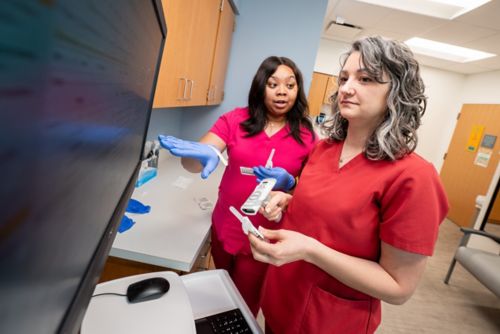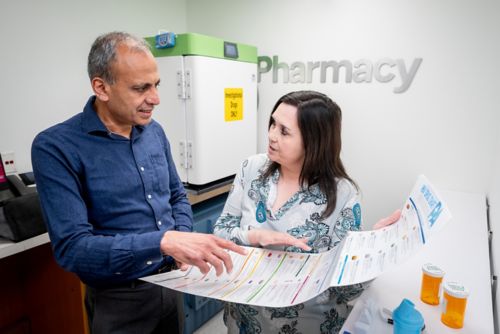St. Jude Family of Websites
Explore our cutting edge research, world-class patient care, career opportunities and more.
St. Jude Children's Research Hospital Home

- Fundraising
St. Jude Family of Websites
Explore our cutting edge research, world-class patient care, career opportunities and more.
St. Jude Children's Research Hospital Home

- Fundraising
For four decades, the HIV and Translational Medicine Program at St. Jude has advanced treatment and prevention options for children and youths living with, and striving to prevent, HIV.
Children and youths are groups for whom innovation often lags that for adults. Yet from initial treatments which required taking multiple pills several times a day, to one pill daily, to two intramuscular injections given once every two months, St. Jude has played a role in the progress that has transformed HIV from a life-threatening disease into a manageable chronic condition.
Research that provides new treatment options for younger populations
St. Jude has helped accelerate the U.S. Food and Drug Administration (FDA) and Canada Health approval timeline for the combined administration of the long-acting injectable antiretrovirals cabotegravir and rilpivirine in adolescents (aged 12 to 18 years). The approach was tested through the phase 1/2 International Maternal Pediatric Adolescent AIDS Clinical Trials (IMPAACT) Network clinical trial co-led by Aditya Gaur, MD, Division of HIV and Translational Medicine director and Department of Infectious Diseases, and his colleague Carolyn Bolton-Moore at the Centre for Infectious Disease Research in Zambia, Africa.
Results from the study, also referred to as the More Options for Children and Adolescents (MOCHA) study, were published in The Lancet HIV. The study, which involved participants from 15 centers across four countries, showed positive safety, acceptability, and tolerability of this two-drug injectable regimen in youths aged 12 to 17 years.
“There will always be a little bit of lag between when promising drugs or discoveries get approved for adults versus children and youths,” said Gaur. “But for this first all-injectable HIV treatment regimen, approval for use for adolescents in the United States and Canada was relatively soon after the approval for adults, a credit to the IMPAACT 2017 study participants and the collaboration of the National Institutes of Health, ViiV Healthcare, and Janssen R & D, who sponsored the study,”

Members of the Infectious Disease Clinic - Kierra McCallum, RN, and Lauren Braskich, RN - prepare a new treatment option for youth living with HIV: a combination injection of long0term acting antiretrovirals cabotegravir and rilpivirine

Aditya Gaur, MD, and clinical pharmacist Susan Carr, PharmD, review single-tablet treatment options for pediatric patients living with HIV.

We are taking steps to achieve the goal of ending the HIV epidemic [and are] fortunate to walk alongside patients, research participants, and their families as we work toward this future.
Department of Infectious Diseases
Expanding treatment options to even younger populations
The approval brings a new treatment option to adolescents who may struggle with adhering to a one-pill-a-day regimen, the current standard of care.
“When we think of any chronic disease, be it HIV, diabetes or high blood pressure, people struggle with taking medicine every day,” Gaur explained. “Additionally, when you have a condition stigmatized in society, where the act of taking a pill in the presence of someone else may be a reminder that you have HIV, one can see why adhering to a simple, potent, safe one-pill-a-day combination can become even harder.”
St. Jude also participated in a pharmaceutical company–led and sponsored phase 2/3 multicenter trial to assess the safety of co-formulated bictegravir, emtricitabine, and tenofovir alafenamide administered in single-tablet form for 48 weeks in children aged 2 years or older living with virologically suppressed HIV in South Africa, Thailand, Uganda, or the United States.
Initial results published in The Lancet HIV — the first report to assess the safety and dose of a single-tablet option in young children — found the fixed-dose combination of the three medications to be efficacious and well tolerated with good adherence. The findings supported the FDA and European Medicines Agency approval of the low-dose, single-tablet co-formulation as a treatment for HIV in children aged at least 2 years and weighing 14 kg to less than 25 kg. The use of this new formulation was also added to the recommended-use guidelines issued by the U.S. Department of Health and Human Services.
Reflecting on the importance of advancing HIV treatment options to all age groups, Gaur stated that, “the HIV Program at St. Jude is committed to providing the best multidisciplinary care and access to research independent of a person’s ability to afford or access care, and we are taking steps to achieve the goal of ending the HIV epidemic in collaboration with our community partners. We are fortunate to walk alongside patients, research participants, and their families, as we work toward this future.”